Currently, the majority of the world is on lockdown and people are stuck inside their houses. Routines have been thrown off, and many are facing stress, anxiety, and depression.
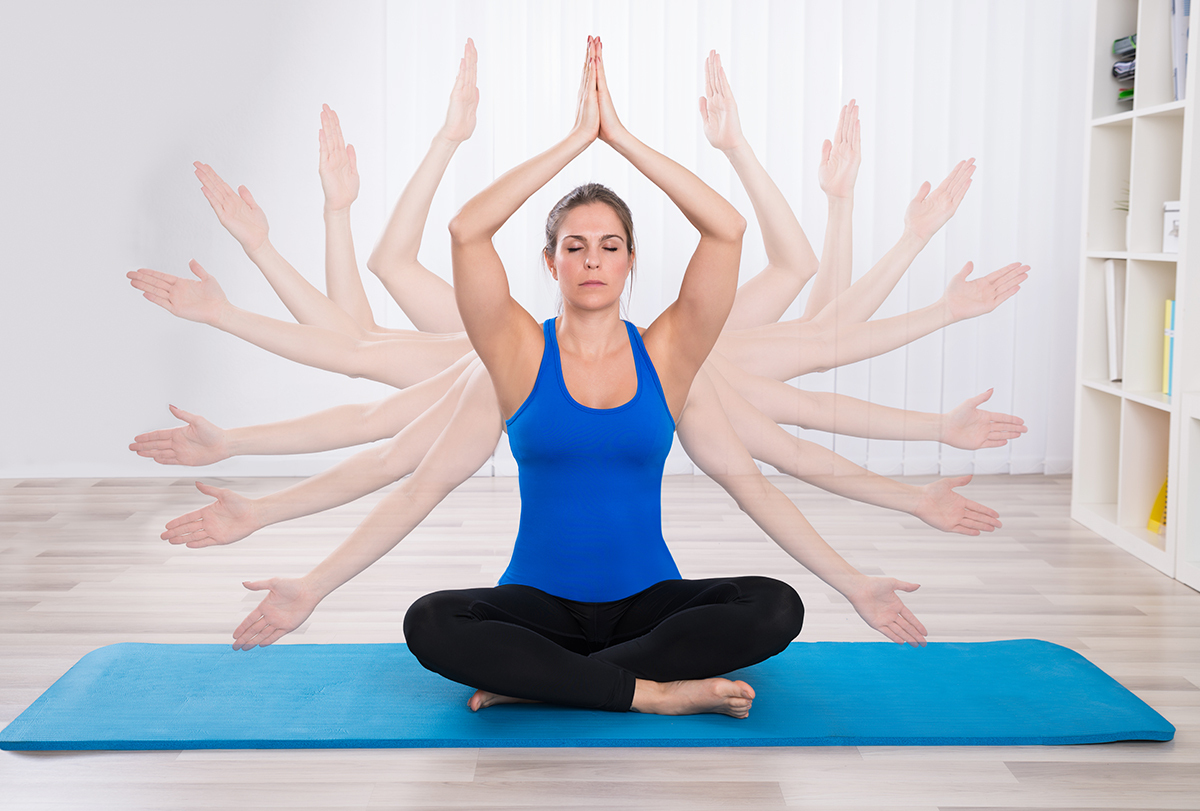
It is very important right now to keep the immune system strong and the body healthy. Luckily, yoga is a tool that everybody always has at their disposal, and it has been proven to decrease stress and anxiety and to strengthen the immune system. (1)
Yoga also keeps the body moving, the blood pumping, and the muscles strong. (2)(3)
10 Yoga Poses to Practice During the Lockdown
Here are 10 yoga poses that are beneficial to learn and practice during the lockdown.
1. Easy Sitting Pose (Sukhasana)
How to do this pose:
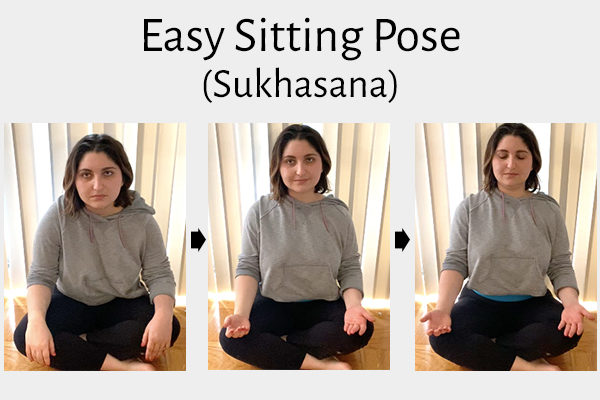
- Start by sitting with the legs crossed.
- Bring the top of the head parallel to the ceiling.
- Hug the core in and use the back muscles to hold the body up.
- This pose can be held for multiple breaths or during meditation.
Benefits of this pose include but are not limited to:
- Strengthening the muscles in the back, hips, legs, and ankles
- Increasing flexibility in the hips, thighs, groin, and knees
- Promoting a calm mind
- Decreasing stress and anxiety (1)
- Helping to feel more grounded
- Correcting posture
- Opening up the back of the body
If your knees cannot reach the ground or if sitting cross-legged is hard, yoga blocks or bolsters can be placed beneath the knees for support. If these props are not owned, pillows can be used in their place.
This pose can be done during breathing exercises and meditations. The pose can be held for as long as comfortable.
2. Child’s Pose (Balasana)
How to do this pose:
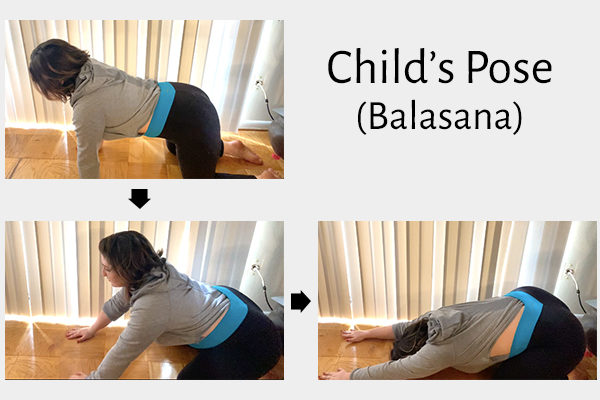
- Start on the hands and knees.
- Press the hips back over the heels.
- Stretch the arms out in front of the body, and rest the forehead on the ground.
Benefits of this pose include but are not limited to:
- Stretching the back, feet, ankles, hips, arms, and shoulders
- Promoting relaxation
- Decreasing stress and anxiety (1)
- Promoting a calm mind
- Helping to feel more grounded
This pose has many variations and can be customized for the person practicing it. If sitting back on your heels is difficult to do, your knees can be out to the side. The arms can also be brought down by the side if this is more comfortable. However, stretching your arms out in front of the body allows for a deeper, more active version of the stretch.
If your forehead does not reach the ground, a block or a pillow can be used to rest the head on. This pose can be held for as long as comfortable.
3. Pigeon Pose (Eka Pada Rajakapotasana)
How to do this pose:

- Start on the hands and knees.
- Choose one side to start with (the left side will be used for this explanation), and then remember to do the same to the other side.
- Bring the left knee to the left wrist.
- Flexing the left foot, bring the left ankle toward the right wrist.
- Slide the right leg back behind the body with the top of the foot resting on the ground.
- The pose can either be held in this position, or it can be deepened by laying the upper body over the left leg and bringing the head to the ground.
Benefits of this pose include but are not limited to:
- Deeply stretching the hips, legs, and glutes
- Opening up the back of the body and the hip rotators
- Correcting posture
- Releasing strain on the lower back
- Increasing flexibility, especially in the hips
- Decreasing stress (1)
This is another pose that has many variations. All versions of this pose are very helpful for relaxing and stretching out the body and releasing the tension stored in the joints.
When going into this pose, be careful to listen to your body so that you do not overextend. If your hips do not rest comfortably on the ground, a block or pillow can be placed beneath them for support. The hips should always stay squared toward the ground.
This pose can be held for 1–2 minutes or for as long as comfortable. It should be held for the same amount of time on each side.
4. Cobra Pose (Bhujangasana)
How to do this pose:
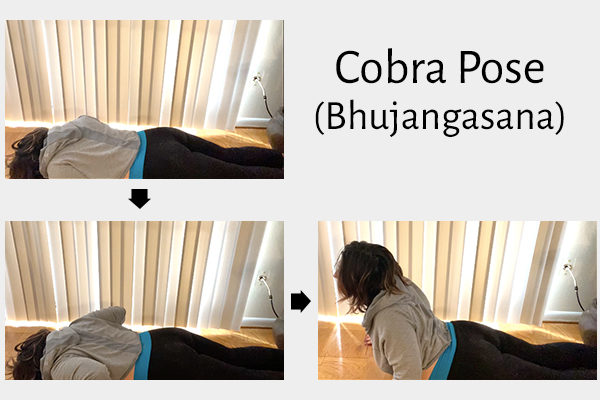
- Start on the belly with the legs stretched out behind the body.
- Keeping the legs together, bring the hands flat on the ground beneath the shoulders.
- On the inhale, lift the chest by using the muscles of the back and gently pressing into the hands.
Benefits of this pose include but are not limited to:
- Increased flexibility of the spine
- Flushing out toxins from the body (especially the kidneys)
- Strengthening the arms, chest, back, neck, abdomen, and shoulders
- Opening the heart and lungs
- Aiding the digestive system
- Decreasing stress, anxiety, and depression (1)
This pose is often done incorrectly, so you should take your time when going into this pose. Be careful to only press up as far as you can while using the muscles in the back.
You can hold this pose for 30 seconds or as long as comfortable.
5. Boat Pose (Navasana)
How to do this pose:
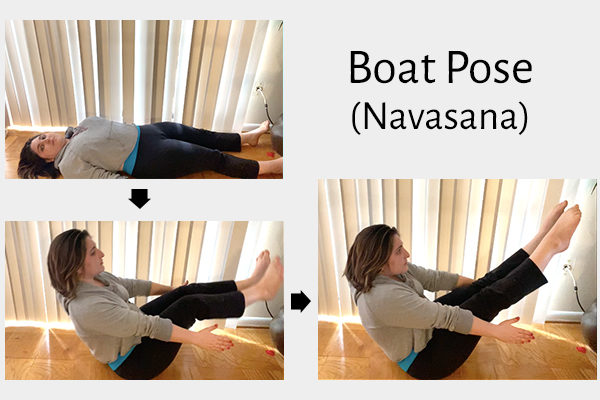
- Start by lying on the back.
- On the inhale, lift the upper body and the legs into the air.
- Use the core to hold the body up and continue breathing deeply.
- The knees can be bent for an easier version of the pose, or they can be perfectly straight with the toes pointed to the ceiling and the arms extended toward the knees
Benefits of this pose include but are not limited to:
- Strengthening the core, legs, and arms
- Improving organ function and digestion
- Correcting posture
- Improving balance
- Promoting self-confidence
- Relieving stress and anxiety
- Opening the hip flexors
This pose is a great one for keeping the muscles strong if you are currently unable to go to a gym. This pose has different variations depending on the level of difficulty you desire.
Make sure to use your core in this pose to lift the body. The spine should always be kept straight for proper posture.
You can hold this pose for 30 seconds to 1 minute or as long as comfortable.
6. Legs Up the Wall Pose (Viparita Karani)
How to do this pose:
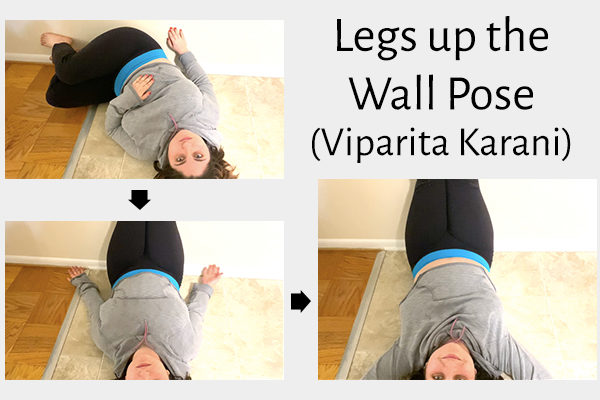
- Come close to the wall that is being used for this pose.
- Start on the side with the knees bent, and bring the glutes up to the wall.
- Rotate the legs up with the glutes kept against the wall.
- Straighten the legs completely and relax into the pose, taking slow, deep breaths.
Benefits of this pose include but are not limited to:
- Opening up the lower back
- Releasing tension in the back
- Increasing proper circulation
- Decreasing swelling in the legs, ankles, and feet
- Stretching the back, legs, and hamstrings
- Correcting posture
- Promoting relaxation
- Decreasing anxiety, stress, and depression
- Increasing energy
- Strengthening the immune system
- Relieving headaches, menstrual cramps, and back pain
This pose is a wonderful restorative pose. It can be held for long periods. By being upside down, the body can reverse blood flow and drain the toxins from the lymph nodes and kidneys.
7. Warrior II (Virabhadrasana II)
How to do this pose:
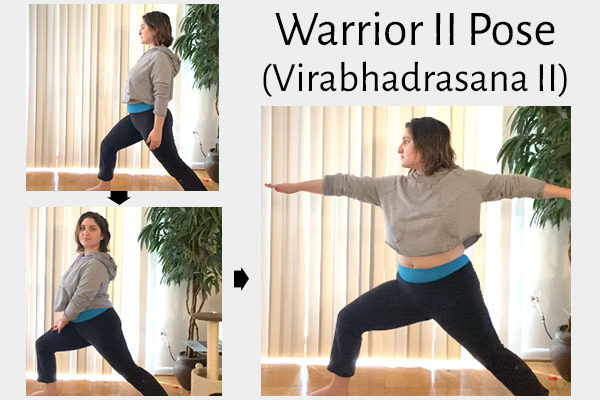
- Start in a high lunge.
- Rotate the back foot to a 45° angle.
- Keeping the front knee bent, bring the arm of the same side out in front and the opposite arm straight to the back, keeping them parallel with one another.
- Pick an unmoving point of focus to stare at.
Benefits of this pose include but are not limited to:
- Strengthening the hips, legs, shoulders, abs, and arms
- Decreasing tension and pain in the legs
- Opening the hips and chest
- Decreasing anxiety
- Increasing balance
- Promoting focus and meditation
When doing this pose, your front knee should never go over the toes. Rest your gaze on a stationary object to help with balance and focus. This unmoving point is known as the “drishti.”
This pose can be held for at least 30 seconds to 1 minute or as long as comfortable. The pose should be held for an equal amount of time on both sides.
8. Downward-Facing Dog Pose (Adho Mukha Svanasana)
How to do this pose:
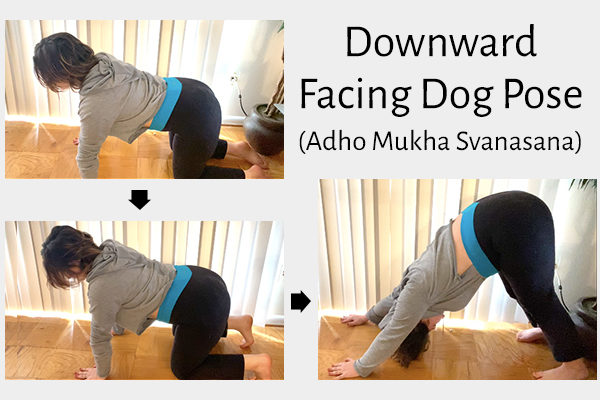
- Start on the hands and knees with the hands directly under the shoulders.
- Tuck the toes.
- Pressing into the hands and toes, lift the knees from the ground.
- Relax the head on the neck and breathe deeply.
Benefits of this pose include but are not limited to:
- Relieving menstrual cramps
- Strengthening the muscles of the arms, legs, back, and shoulders
- Stretching the back, shoulders, arms, legs, and hips
- Increasing balance
- Increasing energy
- Decreasing anxiety
It is important to keep your back aligned and straightened in this pose, even if it means bending the knees at first. This pose can be held for five breaths or as long as comfortable.
Caution: This pose should not be done if you have high blood pressure or are in the later stages of pregnancy.
9. Half Lord of Fish Pose (Ardha Matsyendrasana)
How to do this pose:
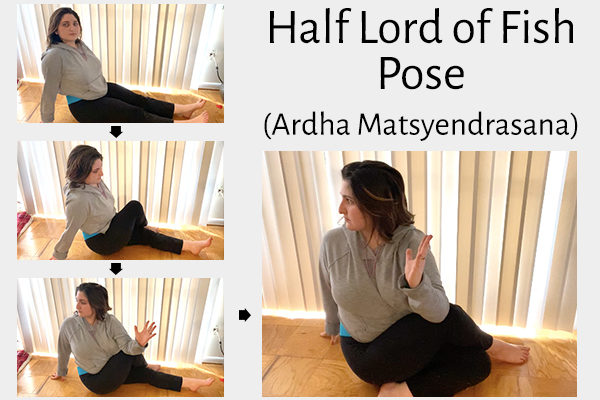
- Bring the legs out, in front of the body.
- Pick a side to start on (the left side will be used for this explanation) and then remember to do the same to the other side.
- Lift the left leg, and cross it over the right until the left foot is flat on the ground with the heel by the right hip.
- Bring the right elbow to the outside of the left thigh.
- Bring the right knee behind the body with the palm or fingertips on the ground.
- This position can be the last step, or the pose can be made more difficult by crossing the right leg under and around the body.
Benefits of this pose include but are not limited to:
- Relieving pain in the back
- Increasing energy
- Decreasing tiredness
- Releasing toxins from the body
- Relieving menstrual cramps
- Promoting the health of the liver and kidneys
- Promoting a calm mind
- Decreasing stress and anxiety
- Correcting posture
- Opening up the back of the body and the abdomen
With each inhale, you can lift up higher, and with each exhale, you can twist deeper. The last thing that should twist behind the body is the gaze. This pose can be held for about 30 seconds to 1 minute on each side or as long as comfortable.
10. Bridge Pose (Setu Bandha Sarvangasana)
How to do this pose:
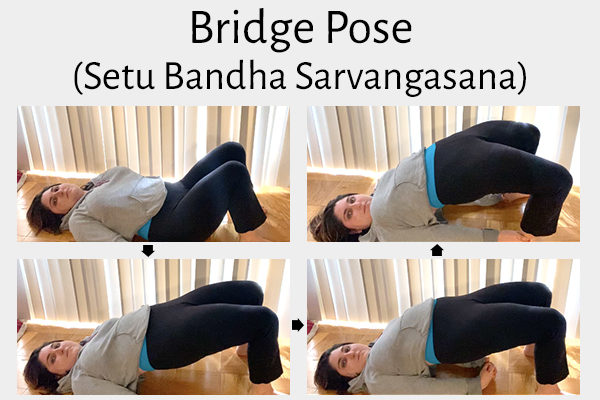
- Start by lying on the back with the feet flat on the ground.
- Bring the hands down by the sides.
- On the inhale, lift the hips up by pressing into the hands and using the muscles of the core.
- This position can be the last step, or you can join the hands together beneath the body or reach for the ankles for a deeper stretch.
Benefits of this pose include but are not limited to:
- Relieving pain in the back
- Strengthening the back, legs, hips, and core
- Increasing relaxation
- Decreasing tiredness
- Improving the health of the organs
- Increasing proper digestion
- Decreasing stress and anxiety
- Opening up the shoulders, neck, chest, and upper back
- Increasing energy
You can also do a more restorative version of this pose by placing a block, bolster, or rolled pillow beneath your glutes. From here, the knees can stay bent or the legs can straighten out in front of the body.
This pose can be held for about 30 seconds to 1 minute or as long as comfortable.
Final Word
Living in these unprecedented and uncertain times has taken quite a toll on people’s mental well-being. Stress levels are at an all-time high, which is only compounded by the lockdown that has confined people into their homes.
People are too caught up in mitigating the personal and professional ramifications of this pandemic that they are ignoring their health.
The lack of movement on account of the lockdown plus the looming anxieties about the future has contributed to both physical and emotional breakdown.
But it is very important to come to terms with this reality and take control of your health to keep yourself safe and sane. While you can’t go out running or to the gym, there’s still plenty you can do at home to stay fit.
Yoga is perhaps the most relaxing and restorative exercise that can help you center your mind, ease the tension, stimulate your immune system, and build your stamina while keeping you energized and flexible.
- Was this article helpful?
- YES, THANKS!NOT REALLY


